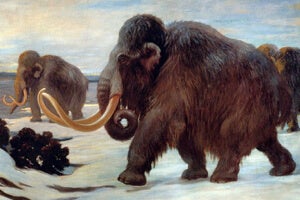
More than a decade after their first attempt, a team of Japanese scientists have announced that they will aim to clone a woolly mammoth in the next five years. Led by Akira Iritani, the team plans on taking mammoth DNA extracted from preserved corpses found in Siberia and inserting it into African elephant eggs that have had their DNA removed. If the insertion is successful, the eggs will be placed in an adult elephant and brought to term. Kinki University’s Faculty of Biology Oriented Science and Technology tried to do exactly this three times previously, starting in 1997. Yet damage to mammoth cells due to extreme cold prevented their success. Now, another Japanese scientist, Teruhiko Wakayama of RIKEN, has developed a technique that allowed him to clone a mouse from a body frozen for 16 years. Iritani’s group is hoping that this technique will provide the missing ingredient that allows them to succeed. Work to find suitable DNA has begun, and Iritani believes they could have a walking, breathing mammoth in just five to six years. Bring on the clones!
As we recently discussed, scientists have been pursuing cloning endangered and extinct species with middling success. Kinki University’s attempts with mammoths have been no exception. Frost damage makes the DNA in many mammoth specimens mostly worthless. Or at least, that was the consensus earlier in the decade. Then in 2008, Wakayama’s clone of a mouse dead and frozen for 16 years changed the rules. With mice, he was able to use DNA to create partially viable embryos, then use the embryonic cell DNA to create clones. Similar or modified techniques may allow Iritani and his team to take mammoth DNA previously considered too damage to be viable, and boot strap it into a clone.
According to the Daily Yomiuri, Iritiani and his colleagues have already begun to assemble a team of scientists from Japan, the US, and Russia to complete the ‘Mammoth Creation Project’. They’ve asked zoos from around the world to donate eggs from African elephants after they die. Assuming a few years to find suitable mammoth DNA and adapt Wakayama’s techniques for this experiment, and 600 days of gestation once the clone is implanted in an adult African elephant, we could have a mammoth birth in five years or so.
The re-creation of an extinct species has raised serious questions about the ethics of the experiment:
“If a cloned embryo can be created, we need to discuss, before transplanting it into the womb, how to breed [the mammoth] and whether to display it to the public. After the mammoth is born, we’ll examine its ecology and genes to study why the species became extinct and other factors.”
— Akira Iritani, Daily Yomiuri, 2011
I’m of the opinion, however, that the rebirth of an extinct species is really only a matter of time. We’ve seen how the Mammoth Genome Project at Penn State is hoping to create their own woolly by modifying African elephant DNA. The Neanderthal Genome Project, or ancient human genome sequencing at BGI in China, could enable similar attempts for creatures much closer to ourselves. As our successes with cloning continue to mount, the chances for any of these teams to reproduce an extinct or endangered mammal will improve. Iritani’s team in Japan may be unable to produce a mammoth in the next five years (they have failed before), yet the field of cloning is moving in that direction. Jurassic Park may be out of reach, but Pleistocene Park looks like it could be opening soon.



